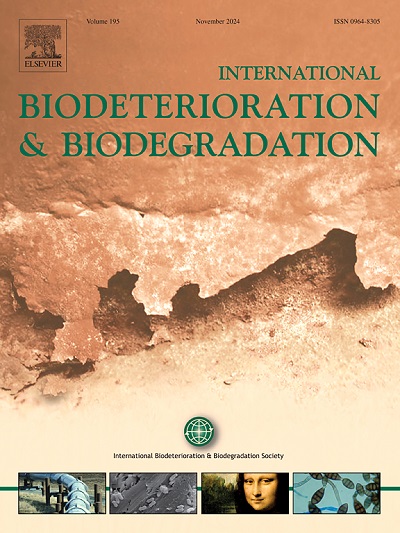Assessing the compost-ability of oil refinery sludge in the presence or absence of earthworms: An eco-friendly approach of biodegradation
IF 4.1
2区 环境科学与生态学
Q2 BIOTECHNOLOGY & APPLIED MICROBIOLOGY
International Biodeterioration & Biodegradation
Pub Date : 2025-02-01
DOI:10.1016/j.ibiod.2024.105987
引用次数: 0
Abstract
Composting offers a low-cost and sustainable approach in waste management, however, knowledge about its feasibility in oil refinery sludge (ORS) bioconversion is unknown. We investigated the efficiency of three composting systems, viz., Eisenia-system (with Eisenia fetida), Eudrilus-system (with Eudrilus eugeniae), and non-earthworm system for ORS bioconversion. The earthworm-based systems recorded greater increment in available nutrients and reduction of heavy metals than non-earthworm system. The Eudrilus-system recorded an increment in total bacterial count by 10%, while P-solubilizing bacteria increased five-folds in Eisenia-system. Additionally, higher economic benefit was observed in terms of net present value (US $ 203.08), benefit-to-cost ratio (0.63) and pay-back time (1 year and 6 months) in the Eudrilus-processed ORS composting approach. The earthworm-based systems also demonstrated higher activity of urease, alkaline phosphatase and dehydrogenase. The clean index (>4) and fertility index (>3.1) of earthworm-sourced composts reflected their high manurial potential. The compost quality index (CQI >7) indicated that presence of earthworms greatly facilitated the bioconversion of ORS due to higher humification and microbial diversity. Principal component analysis identified water holding capacity, total C, NPK, and earthworm growth as the major contributors in CQI. Moreover, the strong influence of enzymes in CQI (R2 = 0.64) was corroborated by the linear regression analysis. Our findings underscore the potential of earthworm-based bio-systems in ORS-remediation, offering a viable way in its management while producing fortified organic manure.

在蚯蚓存在或不存在的情况下评估炼油厂污泥的堆肥能力:一种生态友好的生物降解方法
堆肥为废物管理提供了一种低成本和可持续的方法,然而,其在炼油厂污泥(ORS)生物转化中的可行性尚不清楚。研究了三种堆肥系统,即Eisenia-system(含fetida Eisenia)、Eudrilus-system(含eugenae Eudrilus)和non-蚯蚓系统对ORS生物转化的效率。以蚯蚓为基础的系统比不以蚯蚓为基础的系统增加了更多的有效养分,减少了更多的重金属。eudrilus系统的细菌总数增加了10%,而eisenia系统的p溶解细菌增加了5倍。此外,在净现值(203.08美元)、效益成本比(0.63)和回报时间(1年6个月)方面,eudrilus处理的ORS堆肥方法具有更高的经济效益。蚯蚓基体系脲酶、碱性磷酸酶和脱氢酶活性也较高。蚯蚓源堆肥的清洁指数(>4)和肥力指数(>3.1)反映出蚯蚓源堆肥具有较高的施肥潜力。堆肥质量指数(CQI >7)表明蚯蚓的存在极大地促进了ORS的生物转化,因为蚯蚓具有较高的腐殖化和微生物多样性。主成分分析表明,土壤持水量、总碳、氮磷钾和蚯蚓生长是CQI的主要贡献因子。线性回归分析证实酶对CQI有较强的影响(R2 = 0.64)。我们的发现强调了以蚯蚓为基础的生物系统在ors修复中的潜力,为其管理提供了一种可行的方法,同时生产强化有机肥。
本文章由计算机程序翻译,如有差异,请以英文原文为准。
求助全文
约1分钟内获得全文
求助全文
来源期刊
CiteScore
9.60
自引率
10.40%
发文量
107
审稿时长
21 days
期刊介绍:
International Biodeterioration and Biodegradation publishes original research papers and reviews on the biological causes of deterioration or degradation.

 求助内容:
求助内容: 应助结果提醒方式:
应助结果提醒方式:


